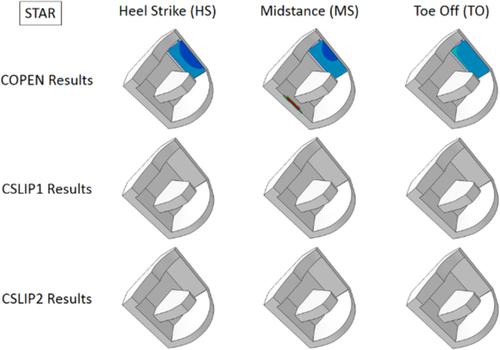当前位置:
X-MOL 学术
›
Int. J. Numer. Method. Biomed. Eng.
›
论文详情
Our official English website, www.x-mol.net, welcomes your
feedback! (Note: you will need to create a separate account there.)
Finite element analysis of bone-prosthesis interface micromotion for cementless talar component fixation through critical loading conditions.
International Journal for Numerical Methods in Biomedical Engineering ( IF 2.2 ) Pub Date : 2020-01-28 , DOI: 10.1002/cnm.3310 Irwan S M Moideen 1 , Chin Tat Lim 2 , Raye C H Yeow 1 , Desmond Y R Chong 3
International Journal for Numerical Methods in Biomedical Engineering ( IF 2.2 ) Pub Date : 2020-01-28 , DOI: 10.1002/cnm.3310 Irwan S M Moideen 1 , Chin Tat Lim 2 , Raye C H Yeow 1 , Desmond Y R Chong 3
Affiliation

|
The total ankle replacement (TAR) survivability rate is still suboptimal, and this leads to many orthopaedic surgeons opting arthrodesis as a better option for the ankle arthritis patients. One of the fundamental reasons is due to the lack of primary stability of the prosthesis fixation at the bone‐prosthesis interface hence leading to long‐term aseptic loosening of the talar component. The commercially available Scandinavian Total Ankle Replacement (STAR) Ankle design and several additional design features (including trabecular metal, side fin, double fin, and polka‐dot designs) were studied using finite element analysis, and the bone‐prosthesis interface relative micromotion (BPIRM) and talar bone minimum principal stresses were examined and analysed. Three loading conditions at a gait cycle of heel strike, midstance, and toe off with different meniscal bearing displacement were also included as part of the study parameters. The results were correlated to in vitro cadaveric measurements and reported clinical studies. Simulated results showed that the de‐bonding relative distance between the bone and prosthesis upon loading (COPEN defined by the simulation software) was the main reason constituting to the high interface micromotion between the talar component and talus bone (which could lead to long‐term aseptic loosening). The polka‐dot design was shown to induce the lowest BPIRM among all the designs studied.
中文翻译:

骨-假体界面微动的有限元分析,用于通过关键载荷条件固定非骨水泥距骨组件。
踝关节置换术(TAR)的总生存率仍然不理想,这导致许多骨科医生选择将关节固定术作为踝关节炎患者的更好选择。根本原因之一是由于假体在骨-假体界面处的固定缺乏主要稳定性,因此导致距骨组件的长期无菌性松动。使用有限元分析研究了市售的斯堪的纳维亚全踝置换(STAR)踝设计和其他一些设计特征(包括小梁金属,侧鳍,双鳍和圆点设计),以及假体界面相对微运动(检查并分析了距骨的最小主应力。脚跟打击,中间姿势,研究参数还包括具有不同半月板轴承位移的脚趾和脚趾。结果与体外尸体测量相关,并报告了临床研究。模拟结果表明,加载时骨骼与假体之间的脱粘相对距离(由模拟软件定义的COPEN)是造成距骨组件与距骨之间高界面微运动的主要原因(这可能导致长期无菌松动)。在所有研究的设计中,圆点设计显示出最低的BPIRM。模拟结果表明,加载时骨骼与假体之间的脱粘相对距离(由模拟软件定义的COPEN)是造成距骨组件与距骨之间高界面微运动的主要原因(这可能导致长期无菌松动)。在所有研究的设计中,圆点设计显示出最低的BPIRM。模拟结果表明,加载时骨骼与假体之间的脱粘相对距离(由模拟软件定义的COPEN)是造成距骨组件与距骨之间高界面微运动的主要原因(这可能导致长期无菌松动)。在所有研究的设计中,圆点设计显示出最低的BPIRM。
更新日期:2020-01-28
中文翻译:

骨-假体界面微动的有限元分析,用于通过关键载荷条件固定非骨水泥距骨组件。
踝关节置换术(TAR)的总生存率仍然不理想,这导致许多骨科医生选择将关节固定术作为踝关节炎患者的更好选择。根本原因之一是由于假体在骨-假体界面处的固定缺乏主要稳定性,因此导致距骨组件的长期无菌性松动。使用有限元分析研究了市售的斯堪的纳维亚全踝置换(STAR)踝设计和其他一些设计特征(包括小梁金属,侧鳍,双鳍和圆点设计),以及假体界面相对微运动(检查并分析了距骨的最小主应力。脚跟打击,中间姿势,研究参数还包括具有不同半月板轴承位移的脚趾和脚趾。结果与体外尸体测量相关,并报告了临床研究。模拟结果表明,加载时骨骼与假体之间的脱粘相对距离(由模拟软件定义的COPEN)是造成距骨组件与距骨之间高界面微运动的主要原因(这可能导致长期无菌松动)。在所有研究的设计中,圆点设计显示出最低的BPIRM。模拟结果表明,加载时骨骼与假体之间的脱粘相对距离(由模拟软件定义的COPEN)是造成距骨组件与距骨之间高界面微运动的主要原因(这可能导致长期无菌松动)。在所有研究的设计中,圆点设计显示出最低的BPIRM。模拟结果表明,加载时骨骼与假体之间的脱粘相对距离(由模拟软件定义的COPEN)是造成距骨组件与距骨之间高界面微运动的主要原因(这可能导致长期无菌松动)。在所有研究的设计中,圆点设计显示出最低的BPIRM。











































 京公网安备 11010802027423号
京公网安备 11010802027423号